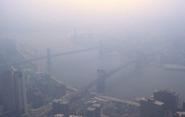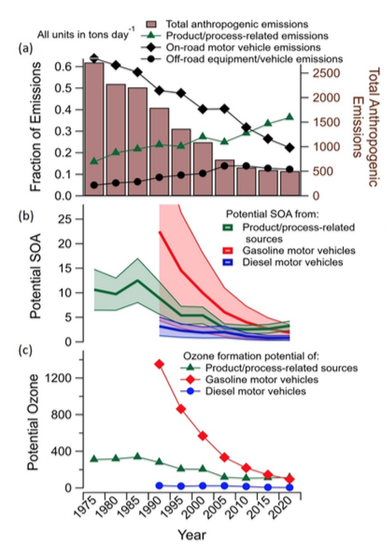Study Shows Need to Broaden Focus on Sources of Air Pollution

From the new carpet in your house to the foam cushions in your couch, your cleaning products, or the asphalt in the street, numerous non-combustion-related sources emit smog-forming compounds into the atmosphere. A new study from Yale researchers shows the critical need to know more about these extremely diverse emissions to continue improving urban air quality over the coming decades.

Since the 1960s, air pollution research and control policies focused more on emissions from motor vehicles and other combustion-related sources, and have yielded impressive results. But as those efforts succeeded, reactive organic pollutants from other sources have taken on greater prominence.
Drew Gentner, Assistant Professor of Chemical & Environmental Engineering, says that greater attention needs to be paid to this diverse mix of other sources, so that we can better understand its role in photochemical smog and develop holistic control strategies. He and Peeyush Khare, a Ph.D. student in Gentner’s lab, have published their findings today in Atmospheric Chemistry and Physics.
“For years, the decision was made to focus VOC (volatile organic compound) control efforts more on motor vehicles, and that was the right decision at the time,” Gentner said. “Now, these other non-combustion sources are a major factor, and in many cases, becoming the dominant factor in determining ozone and SOA levels in urban areas and downwind.”
The researchers’ study focuses on emissions of reactive organic gases that lead to the formation of detrimental ground-level ozone and secondary organic aerosol (SOA), and demonstrates that non-combustion-related sources now play a major role. Individually, these compounds may seem minor. Collectively, however, they now rival – and eclipse in some cases - the emissions levels of combustion-related sources.
Existing policies for consumer products and solvents have focused on volatile organic compounds (VOCs) – reactive organic gases you can often smell at high concentrations -- that react to form ozone and SOA. Emissions inventories for outdoor air quality, however, have tended to underrepresent intermediate-volatility (IVOCs) and semi-volatile organic compounds (SVOCs). As a result, these human-generated compounds are exempt from most emissions targets even though they play a significant role in SOA formation. Exactly how much it’s contributing to SOA, though, is unknown.
“We do not currently know the full range of sources and chemical compounds contributing to overall emissions.” Khare says. “We use a diverse range of products and materials in our personal lives, in industry, and in commercial operations. Put together, they end up being a lot of things with a wide variety of emissions.”
These compounds come from a diverse array of sources, including paint, asphalt, household cleaners, adhesives, sealants, and various building materials. Many have eluded scrutiny because the technology to track their effect on the atmosphere was limited. Plus, those that could be measured were overwhelmed by contributions from combustion-related sources.
Even when these compounds are detected, their contribution to SOA is often misattributed to fossil sources such as on-road vehicles.
"That's because most products and chemicals we use are derived from petroleum feedstocks, so their isotopic signature matches fossil fuel-based emission sources.” Khare said.
In the paper, they analyze a range of products and demonstrate that the isotopic ratios of emissions from a mix of products will indeed have the same patterns as fossil fuels.
“For many of the compounds, there’s limited information on product and material organic composition because there are insufficient reporting requirements,” Gentner said. “Historically, they were challenging to measure and were viewed as minor components, and it was assumed that they have a negligible impact.”
With better capabilities to analyze these compounds, the researchers say, we need to constrain these emissions through chemical analyses of products, more thorough emissions inventories, and better calculations of the timescales of these emissions, which can vary from minutes to years.
“Our ability to measure things and our level of understanding of the diversity of emissions has increased,” Gentner said. “In the last 10 to 15 years, our understanding of the full range of gas-phase organics – not just VOCs but SVOCs and IVOCs – has enabled us to get a more complex picture of the reactive compounds being emitted.”
With this more complete picture, Gentner said, the field will be in a better position to study the emissions from these sources - similar to the efforts that led to significant reduction of emissions from combustion-related sources.
“We need to gain a deeper understanding of their emissions and figure out what sources and compounds play the most important roles in urban areas nationally and internationally,” he said. “Then we can determine the most important research goals and form policies. It’s important to approach this with a rigorous strategy since it is such a complex multifaceted problem.”
Khare and Gentner note that motor vehicles and other combustion sources are not off the hook, since they are still important sources of many pollutants. Rather, the researchers stress the need for a holistic approach to air pollution control over the coming decades.

